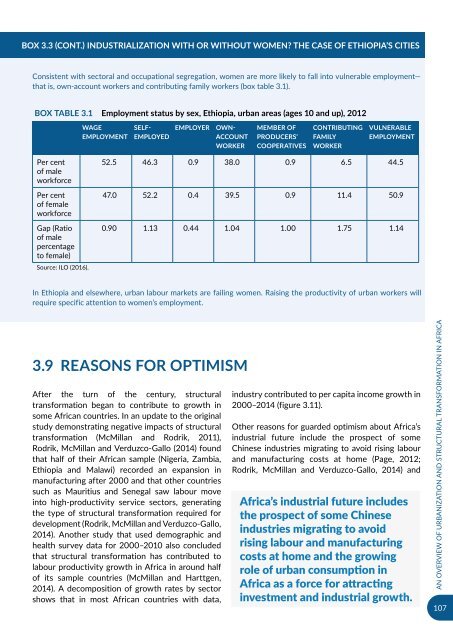URBANIZATION AND INDUSTRIALIZATION
Economic%20Report%20on%20Africa%202017%20UNECA
Economic%20Report%20on%20Africa%202017%20UNECA
You also want an ePaper? Increase the reach of your titles
YUMPU automatically turns print PDFs into web optimized ePapers that Google loves.
BOX 3.3 (CONT.) <strong>INDUSTRIALIZATION</strong> WITH OR WITHOUT WOMEN? THE CASE OF ETHIOPIA’S CITIES<br />
Consistent with sectoral and occupational segregation, women are more likely to fall into vulnerable employment—<br />
that is, own-account workers and contributing family workers (box table 3.1).<br />
Box Table 3.1 Employment status by sex, Ethiopia, urban areas (ages 10 and up), 2012<br />
WAGE<br />
EMPLOYMENT<br />
SELF-<br />
EMPLOYED<br />
EMPLOYER<br />
OWN-<br />
ACCOUNT<br />
WORKER<br />
MEMBER OF<br />
PRODUCERS’<br />
COOPERATIVES<br />
CONTRIBUTING<br />
FAMILY<br />
WORKER<br />
VULNERABLE<br />
EMPLOYMENT<br />
Per cent<br />
of male<br />
workforce<br />
Per cent<br />
of female<br />
workforce<br />
Gap (Ratio<br />
of male<br />
percentage<br />
to female)<br />
Source: ILO (2016).<br />
52.5 46.3 0.9 38.0 0.9 6.5 44.5<br />
47.0 52.2 0.4 39.5 0.9 11.4 50.9<br />
0.90 1.13 0.44 1.04 1.00 1.75 1.14<br />
In Ethiopia and elsewhere, urban labour markets are failing women. Raising the productivity of urban workers will<br />
require specific attention to women’s employment.<br />
3.9 REASONS FOR OPTIMISM<br />
After the turn of the century, structural<br />
transformation began to contribute to growth in<br />
some African countries. In an update to the original<br />
study demonstrating negative impacts of structural<br />
transformation (McMillan and Rodrik, 2011),<br />
Rodrik, McMillan and Verduzco-Gallo (2014) found<br />
that half of their African sample (Nigeria, Zambia,<br />
Ethiopia and Malawi) recorded an expansion in<br />
manufacturing after 2000 and that other countries<br />
such as Mauritius and Senegal saw labour move<br />
into high-productivity service sectors, generating<br />
the type of structural transformation required for<br />
development (Rodrik, McMillan and Verduzco-Gallo,<br />
2014). Another study that used demographic and<br />
health survey data for 2000–2010 also concluded<br />
that structural transformation has contributed to<br />
labour productivity growth in Africa in around half<br />
of its sample countries (McMillan and Harttgen,<br />
2014). A decomposition of growth rates by sector<br />
shows that in most African countries with data,<br />
industry contributed to per capita income growth in<br />
2000–2014 (figure 3.11).<br />
Other reasons for guarded optimism about Africa’s<br />
industrial future include the prospect of some<br />
Chinese industries migrating to avoid rising labour<br />
and manufacturing costs at home (Page, 2012;<br />
Rodrik, McMillan and Verduzco-Gallo, 2014) and<br />
Africa’s industrial future includes<br />
the prospect of some Chinese<br />
industries migrating to avoid<br />
rising labour and manufacturing<br />
costs at home and the growing<br />
role of urban consumption in<br />
Africa as a force for attracting<br />
investment and industrial growth.<br />
AN OVERVIEW OF <strong>URBANIZATION</strong> <strong>AND</strong> STRUCTURAL TRANSFORMATION IN AFRICA<br />
107


